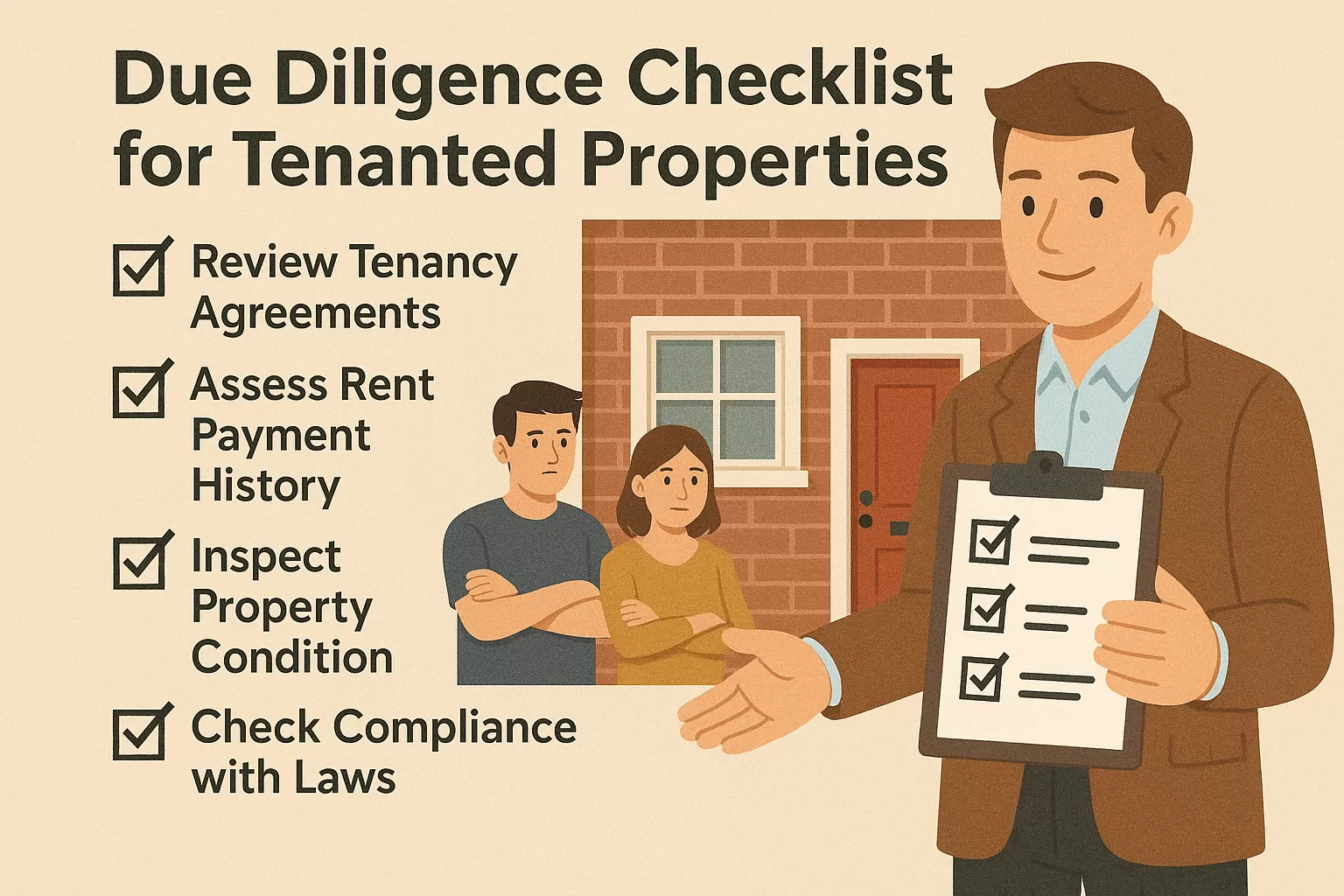Purchasing a property with sitting tenants presents unique investment opportunities and requires specialised due diligence. Unlike vacant properties, tenanted investments come with existing legal relationships, financial arrangements, and potential complications that must be thoroughly investigated before purchase. This comprehensive checklist guides investors through the essential due diligence process for tenanted properties, helping to identify risks, evaluate the actual value, and ensure a sound investment decision.
Tenancy Documentation Review
The foundation of tenanted property due diligence begins with a thorough examination of all tenancy documentation.
Tenancy Agreements
Start with a comprehensive review of all tenancy contracts:
- Agreement completeness: Ensure you have the original signed agreement and all amendments
- Tenancy type verification: Confirm whether AST, assured, regulated, or other tenancy type
- Term structure: Check fixed-term status, expiration dates, and renewal provisions
- Rent details: Verify amount, payment dates, review mechanisms, and increase history
- Deposit arrangements: Confirm the amount, protection scheme, and compliance with regulations
- Special conditions: Note any unusual terms, restrictions, or tenant privileges
- Break clauses: Identify any early termination rights for either party
- Signatures and execution: Verify proper execution by all parties
Missing or incomplete agreements represent a significant risk factor requiring careful consideration.
Tenant History and Profile
Understanding who occupies the property is crucial:
- Tenant identification: Verify all occupants are named on agreements
- Reference checks: Review original tenant references if available
- Payment history: Examine complete rent payment records
- Arrears documentation: Check for current or historical payment issues
- Communication records: Review correspondence history for problem indicators
- Complaint history: Identify any ongoing or recurring tenant complaints
- Maintenance requests: Review the frequency and nature of repair requests
- Tenancy length: Confirm how long current tenants have occupied the property
Long-term, reliable tenants represent a valuable asset, while problematic tenancy histories warrant careful evaluation.
Compliance Documentation
Ensure all regulatory requirements have been met:
- Right to Rent checks: Verify proper immigration status verification
- Gas Safety certificates: Confirm annual inspections are current
- Electrical safety reports: Check EICR compliance (required every 5 years)
- Energy Performance Certificate: Verify minimum E rating for rental properties
- Smoke and carbon monoxide alarms: Confirm proper installation and testing
- HMO licensing: Check for required licenses if the property is a House in Multiple Occupation
- Legionella risk assessment: Verify completion of system of water needed assessment
- Furnishing compliance: Confirm any provided furnishings meet fire safety standards
Non-compliance in these areas can create immediate legal liability for new owners.
Financial Due Diligence
A thorough financial investigation ensures the investment meets expected returns.
Rent Analysis
Verify all aspects of rental income:
- Current rent verification: Cross-check bank statements against claimed rental income
- Market comparison: Assess current rent against market rates for similar properties
- Rent review history: Examine the frequency and percentage of historical increases
- Collection methods: Confirm payment mechanisms and administrative requirements
- Rental guarantee arrangements: Check for any third-party guarantees or insurance
- Arrears patterns: Identify any seasonal or recurring payment issues
- Rent control exposure: Verify if any regulatory rent restrictions apply
- Future income potential: Assess opportunities for rental growth
Discrepancies between reported and actual rental income are common red flags.
Operating Expenses
Understand the actual cost of property ownership:
- Service charge details: Review costs, increases, and tenant contribution arrangements
- Maintenance expenses: Examine historical spending patterns and future requirements
- Insurance costs: Verify current premiums and claims history
- Management fees: Understand existing property management arrangements and costs
- Ground rent: For leasehold properties, confirm current and projected ground rent
- Utility responsibilities: Clarify which services are landlord vs. tenant obligations
- Tax considerations: Assess council tax or business rate implications
- Void period history: Check the frequency and duration of historical vacancies
Underestimated expenses can significantly impact investment returns.
Deposit Handling
Proper deposit management is legally required:
- Protection verification: Confirm deposits are protected in approved schemes
- Transfer arrangements: Understand the process for transferring protection to the new owner
- Deduction history: Review any previous deposit deductions or disputes
- Prescribed information: Verify tenants received required deposit protection information
- Deposit adequacy: Assess whether deposit amounts provide adequate protection
- Interest arrangements: Check if any interest accrual terms apply
- Alternative schemes: Identify any deposit replacement products or arrangements
- Compliance timeline: Verify deposits were protected within the required timeframes
Deposit protection failures can result in significant financial penalties for new owners.
Legal and Regulatory Due Diligence
Understanding the legal framework surrounding the tenanted property is essential.
Property Title Investigation
Standard property checks with tenancy-specific focus:
- Title verification: Confirm seller’s legal right to transfer property with tenancies
- Restrictive covenants: Check for restrictions that might affect tenancy arrangements
- Leasehold restrictions: For leasehold properties, verify permission to sublet
- Planning permissions: Confirm that the property has appropriate permissions for current use
- Building regulations: Verify compliance with relevant building standards
- Boundary disputes: Identify any issues affecting tenant use of the property
- Access rights: Confirm legal access for all parts of property used by tenants
- Shared facilities: Clarify ownership and maintenance responsibilities for common areas
Title issues can affect both property value and the validity of existing tenancies.
Eviction History and Potential

Assess the security of existing tenancies:
- Notice History: Check if any eviction notices have been served
- Court proceedings: Verify if any possession proceedings are active
- Tenant disputes: Identify ongoing disagreements that might lead to legal action
- Grounds for possession: Assess whether any current issues might justify eviction
- Section 21 viability: For ASTs, confirm whether section 21 notices could be served
- Tenant protections: Identify any exceptional circumstances giving tenants enhanced rights
- Eviction costs: Estimate potential expenses if eviction becomes necessary
- Timeline assessment: Project realistic timeframes for obtaining vacant possession if required
Understanding eviction potential is crucial for investors considering future redevelopment or significant changes.
Regulatory Compliance
Ensure the property meets all rental sector regulations:
- Selective licensing: Check if the property is in an area requiring specific landlord licensing
- HMO regulations: Verify compliance with room sizes, facilities, and occupancy limits
- Local authority enforcement: Check for any improvement notices or enforcement actions
- Health and safety compliance: Confirm adherence to all safety regulations
- Minimum standards: Verify property meets Homes (Fitness for Human Habitation) Act requirements
- Accessibility considerations: Identify any disability access requirements or adaptations
- Environmental compliance: Check for issues like asbestos, lead paint, or contamination
- Energy efficiency trajectory: Assess the impact of planned minimum EPC rating increases
Regulatory non-compliance can necessitate significant immediate expenditure.
Physical Property Inspection
Thorough inspection with tenant-specific considerations is essential.
Condition Assessment
Evaluate physical condition with tenancy context:
- General condition: Assess overall state with attention to tenant-caused issues
- Maintenance backlog: Identify deferred maintenance requiring attention
- Tenant alterations: Note any modifications made by tenants
- Wear and tear evaluation: Distinguish normal wear from damage
- Damp and mould issues: Critical in tenanted properties
- Structural concerns: Identify any issues requiring primary intervention
- System functionality: Test heating, plumbing, and electrical systems
- External elements: Assess roof, guttering, windows, and external fabric
Tenant presence can sometimes mask significant property issues.
Inventory Verification
For furnished or partially furnished properties:
- Inventory accuracy: Cross-check existing inventory against actual contents
- Condition documentation: Verify condition records for included items
- Ownership clarity: Confirm which items belong to the landlord vs. the tenants
- Replacement requirements: Identify items needing repair or replacement
- Compliance status: Ensure all furnishings meet current safety standards
- Valuation assessment: Estimate the value of included contents
- Maintenance responsibility: Clarify who maintains specific appliances or fixtures
- End-of-tenancy expectations: Understand return condition requirements
Inventory discrepancies can lead to disputes and unexpected costs.
Tenant Improvements
Assess modifications made by tenants:
- Authorized vs. unauthorized: Identify which changes had landlord permission
- Quality assessment: Evaluate artistry and compliance with standards
- Removal requirements: Determine if modifications must be reversed at the tenancy end
- Value impact: Assess whether changes enhance or detract from property value
- Maintenance implications: Consider ongoing maintenance requirements of alterations
- Safety considerations: Verify modifications don’t create safety hazards
- Regulatory compliance: Ensure changes meet building regulations and planning requirements
- Documentation review: Check for records of permission and agreements.
Tenant improvements can represent either added value or potential liabilities.
Tenant Relationship Assessment
Understanding the human element of tenanted property investment is crucial.
Tenant Interview Opportunities
When possible, direct tenant engagement provides valuable insights:
- Current satisfaction: Gauge overall tenant happiness with the property
- Stay intentions: Understand how long tenants plan to remain
- Improvement requests: Identify desired changes or enhancements
- Relationship history: Assess the quality of the relationship with the current landlord
- Payment patterns: Confirm rent payment arrangements directly
- Maintenance feedback: Get tenant perspective on property condition
- Communication preferences: Understand how tenants prefer to interact
- Plans: Discuss any changing needs or circumstances
Direct tenant conversations often reveal issues not documented in formal records.
Neighbor and Community Factors
External relationships can impact tenancy quality:
- Neighbour complaints: Check for a history of issues with adjacent properties
- Noise considerations: Identify any ongoing noise-related concerns
- Community integration: Assess how well tenants fit within the neighbourhood
- Local amenities: Evaluate access to services essential to tenants
- Transportation links: Consider connectivity for tenant commuting needs
- School quality: For family tenants, assess educational options
- Safety perceptions: Understand tenant views on neighbourhood security
- Development plans: Identify upcoming changes that might affect tenant satisfaction
External factors significantly influence tenant retention and property desirability.
Management Transition Planning
Prepare for a smooth ownership transition:
- Tenant notification requirements: Understand legal obligations to inform tenants
- Rent payment redirection: Plan process for updating payment details
- Point of contact changes: Establish how tenants will communicate with new ownership
- Maintenance request handling: Create a system for addressing ongoing issues
- Relationship reset opportunities: Identify chances to improve tenant relations
- Immediate concerns: Address any pressing issues requiring attention
- Welcome process: Consider how to introduce new ownership positively
- Policy changes: Determine if any management policies will change
Proper transition planning prevents disruption and tenant dissatisfaction.
Investment Analysis
Final evaluation of the tenanted property as an investment opportunity.
Yield Calculation
Accurate return projection based on verified information:
- Gross yield: Annual rent ÷ Purchase price
- Net yield: (Annual rent – Expenses) ÷ Purchase price
- Cash flow projection: Monthly income minus all expenses
- Return on investment: Consider mortgage costs if using financing
- Yield comparison: Benchmark against similar investments
- Stress testing: Calculate returns under different scenarios
- Tax implications: Consider income tax and future capital gains impacts
- Total return projection: Combine rental yield with estimated capital appreciation
Realistic yield calculations based on verified data prevent investment disappointment.
Exit Strategy Assessment
Consider future disposition options:
- Tenant impact on sale: How current tenancies might affect future marketability
- Vacant possession potential: Timeline and process for creating vacancy if desired
- Target buyer identification: Likely future purchaser profile
- Market trend alignment: How property fits with projected market direction
- Improvement potential: Opportunities to enhance value before future sale
- Holding period optimization: Ideal ownership duration for maximum returns
- Tax efficiency planning: Strategies to minimize tax on eventual disposal
- Alternative uses: Potential for conversion or repurposing
A clear understanding of exit strategy prevents future disposition challenges.
Risk Assessment

Comprehensive evaluation of investment risks:
- Tenant default risk: Likelihood of payment problems based on history and profile
- Regulatory change exposure: Vulnerability to evolving landlord-tenant laws
- Property condition risks: Potential for unexpected major repairs
- Market position: How property compares to competing rental options
- Area trajectory: Neighborhood improvement or decline projections
- Expense increase risks: Vulnerability to rising costs
- Financing risks: For leveraged purchases, interest rate sensitivity
- Liquidity considerations: Ease of converting to cash if needed
Thorough risk assessment allows for informed investment decisions and appropriate risk pricing.
The Direct Purchase Alternative
For buyers seeking tenanted properties without extensive due diligence requirements, consider properties available through specialized tenanted property sellers who:
- Pre-verify documentation: Ensure all tenancy paperwork is complete and compliant
- Resolve compliance issues: Address regulatory requirements before sale
- Provide comprehensive information packages: Deliver complete due diligence materials
- Offer transparency: Provide full disclosure of tenant history and property condition
- Streamline transactions: Simplify the purchase process for tenanted investments
- Provide post-sale support: Assist with management transition and tenant relations
These specialized sellers often acquire properties directly from landlords, resolve any issues, and prepare them for seamless transfer to new investors.
Conclusion
Purchasing tenanted property requires specialized due diligence that goes beyond standard property investigations. Investments can make informed decisions that minimise risk and maximise returns by thoroughly examining tenancy documentation, financial performance, legal compliance, physical condition, and tenant relationships.
For investors seeking to simplify the acquisition process, properties available through specialized tenanted property providers offer a streamlined alternative. These properties typically come with complete documentation, resolved compliance issues, and transparent tenant histories, reducing the burden of due diligence while still providing the benefits of immediate rental income.
Whether pursuing traditional acquisition channels or exploring specialized providers, thorough due diligence remains essential. The time invested in comprehensive investigation before purchase can prevent significant problems and expenses throughout the investment lifecycle, ensuring a successful tenanted property investment experience.








